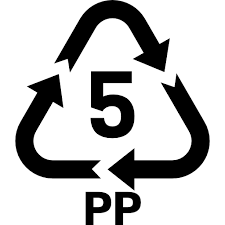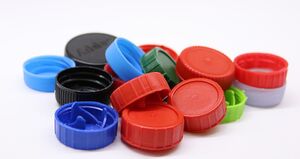PP (5)
PP (Polypropylene) (also known as polypropene) is a type of plastic often used in plastic containers and pipes and is captured as PP (5) in WikiWaste.

PP (5) is a thermoplastic "addition" polymer made from a combination of propylene monomers[1] and is one of the most commonly used thermoplastics in the world. It is a rigid, semi-crystalline thermoplastic that was first polymerised in 1951 and is used widely today in a range of domestic and industrial applications[2] which include packaging for consumer products, plastic parts for various industries including the automotive industry (such as for automotive dashboards and bumpers), mouldings (for sailing dinghies etc) and fibres such as carpets, baling twine and sports clothing[3].
PP (5) can function as both a plastic and fibre type of thermoplastic. This allows for a vastly increased range of uses. It can be used as a fibre, such as in the manufacture of promotional tote bags and ‘bag for life’ shopping carriers. It is soft, malleable and has a relatively low melting point, making it very easy to be used in the injection moulding process, where it is supplied in pellets. It flows well too, due to its low melt viscosity[2]. PP (5) can even withstand twisting motions of up to 360° without snapping and is very hard to snap as a result. High chemical and fatigue resistance adds to its durability and versality as a packaging material and thus it makes a good option for hinges and bottle tops attached to the main bottle by a thin layer of plastic[2].
Examples of PP (5) include[4]:
- Packing tape
- Plastic Straws
- Take away tubs
- Plastic picnic ware
Its one main disadvantage is that PP (5) is not conducive to being easily recycled. When it burns, it produces a chemical change that cannot be reversed[2].Re-heating polypropylene that has already been melted and formed results in it burining rather than being liquifies for a second time, thus other recycling or re-conditioning methods must be considered, at a significantly higher cost[2].
It's low melting point also means that polypropylene is highly flammable and limited in its ability to withstand higher temperatures; it is also susceptible to UV degradation and oxidation. Finally, while polypropylene’s glossy finish makes it aesthetically pleasing and easy to handle, this exact same property also makes it harder to bond to other surfaces and materials, such as paints and glues. Alternative bonding methods, such as welding must be introduced when using polypropylene to make a joint or hinge[2].
- PVC Examples
-
Plastic Bottle Caps (all rights reserved)
-
Polypropylene Rope (all rights reserved)
-
Polypropylene Fabrics (all rights reserved)
Properties
- Strength; resistance to heat, chemicals, grease and oil; moisture barrier.
Common Applications
- Reusable microwaveable ware or take-away containers; kitchenware; yogurt or margerine containers; disposable cups and plates; soft drink bottle caps.



